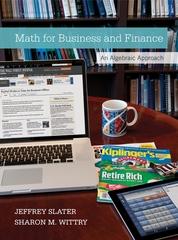Question
1. John Maynard Keynes explains the demand for money includes ______. A. the need to have money for transaction purposes B. the decision to hold
1. John Maynard Keynes explains the demand for money includes ______.
A. the need to have money for transaction purposes
B. the decision to hold money versus financial assets
C. the need to be prepared for emergencies
D. all of the above
2-Imagine the money market. If the supply of money increases due to appropriate monetary policy, the interest rate will ______________, such that the economy will be able to grow and move out of recession.
A. rise, leading to a decrease in Ig and consumer durables spending,
B. rise, leading to an increase in Ig and consumer durables spending,
C. fall, leading to a decrease in Ig and consumer durables spending,
D. fall, leading to an increase in Ig and consumer durables spending
3. Draw the money market . Show an increase in the supply of money.
4. Definition: Demand-pull inflation is defined as the result of too much aggregate spending when the economy is near or at full employment of resources. An appropriate fiscal policy to counteract severe demand-pull inflation:
A. is a tax increase and/or decrease in Government purchases.
B. Is to invoke command authority, and limit consumer and business purchases.
C. a reduction in interest rates by the Federal Reserve.
D. a tax decrease and/or increase in Government purchases.
5. The Aggregate Demand Curve is downward sloping due to ______:
A. the impact on inflation on the purchasing power of the public's financial assets
B. changes in the demand for money leading to an increase in the interest rate
C. the relationship between the price level in the U.S. relative to the price level in other countries
D. all of the above
6. TRUE or FALSE As GDP rises, personal income tax collections and corporate income tax collections automatically rise and transfer payments and subsides automatically decline. EXPLAIN
7. Federal Fiscal policy is primarily carried out by
A. only state governments
B. the Federal Reserve System
C. Congress (Legislative Branch) and the Executive Branch
D. only local governments
8. TRUE or FALSE A $20 bill is a note of the United States Treasury.
9. Expansionary or loose fiscal policy:
A. involves an increase in the nation's money supply by the FED's open market operations for price stability and full employment.
B. automatically decreases the size of government via changes in Government purchases and changes in taxes.
C. is aimed at increasing aggregate demand via changes in Government spending and/or taxes in order to achieve price stability and full employment.
D. reduces the number of senators and representatives currently serving.
10. The amount by which Federal tax revenues are greater than Federal government expenditures during a particular year is ______.
A. Federal Reserve
B. budget deficit
C. budget surplus
D. public debt
11. Fiscal Policy does all of the following EXCEPT:
A. change the composition or make up of aggregate demand.
B. affect the exchange rate and the trade balance.
C. change the amount of money as defined by M2 in the economy.
D. change aggregate demand for goods and services through government spending and taxes.
Step by Step Solution
There are 3 Steps involved in it
Step: 1

Get Instant Access to Expert-Tailored Solutions
See step-by-step solutions with expert insights and AI powered tools for academic success
Step: 2

Step: 3

Ace Your Homework with AI
Get the answers you need in no time with our AI-driven, step-by-step assistance
Get Started


